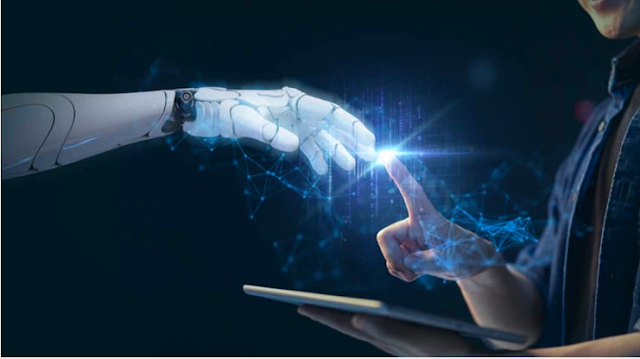Artificial intelligence in the Metaverse
In consumer-facing applications, AI is now playing an important role through facial recognition, natural language processing (NLP), faster computing, and all sorts of other processes.
It was only a matter of time before AI was applied to augmented and virtual reality to create smarter immersive worlds.
AI has the potential to analyze massive amounts of data at lightning speed to generate ideas and drive action. Users can either use AI to make decisions (which is the case for most enterprise applications), or link AI to automation for low-touch processes.
The metaverse will use augmented and virtual reality (AR / VR) combined with artificial intelligence and blockchain to create scalable and accurate virtual worlds.
What is the Metaverse and why does it need AI?
The Metaverse is defined as a vast virtual space where users can interact with 3D digital objects and 3D virtual avatars of each other in a complex manner that mimics the real world.
The idea of the metaverse was first dreamed up by science fiction writer Neil Stevenson in the early 90s and was eventually developed piece by piece by companies such as Second Life, Decentraland, Microsoft, and more recently Meta (formerly Facebook).
Facebook is now well known for its work in artificial intelligence and sophisticated AI algorithms.
The company's AI research spans a variety of areas such as content analysis, self-controlled speech processing, robotic interactions, computer vision, full body posture assessment, and more.
All of this could influence the future direction of a company like Meta and lay the foundations for its own version of the metaverse.
5 use cases for AI in the Metaverse
While VR worlds can technically exist without artificial intelligence, the combination of the two opens up a whole new degree of veracity. The following five use cases can be affected.
Precise avatar creation
Users are at the center of the metaverse, and the accuracy of your avatar will determine the quality of the experience for you and others. The AI engine can analyze 2D images of users or 3D scans to come up with a very realistic simulated interpretation.
He can then create various facial expressions, emotions, hairstyles, aging-related features, etc. to make the avatar more dynamic.
Companies like Ready Player Me are already using AI to create avatars for the metaverse, and Meta is working on its own version of the technology.
Digital people
Digital humans are 3D versions of chatbots that exist in the metaverse. They are not actually copies of another person - instead, they are more like AI-enabled NPCs in a video game that can react and react to your actions in the VR world.
Digital humans are created entirely using AI technologies and are essential to the metaverse landscape.
From NPCs in gameplay to automated VR workplace assistants, there are many applications and companies such as Unreal Engine and Soul Machines have already invested in this direction.
Multilingual availability
One of the main ways digital people use AI is through language processing.
Artificial intelligence can help break down natural languages like English, convert it to a machine-readable format, perform analysis, get an answer, convert the results back to English, and send it back to the user. This whole process takes a split second - like a real conversation.
The best part is that the results can be converted to any language, depending on the AI training, so that users from all over the world can access the metaverse.
Expanding the VR world to scale
This is where AI really comes into its own. When an AI engine is fed historical data, it learns from previous outputs and tries to come up with its own.
The AI output will get better every time, with new input, human feedback, and machine learning reinforcement.
After all, AI will be able to perform a task and provide an output almost as well as humans. Companies like NVIDIA are teaching AI to create entire virtual worlds.
This breakthrough will play an important role in the scalability of the metaverse as new worlds can be added without human intervention.
Intuitive pairing
Finally, AI can also aid in human-computer interaction (HCI). When you wear a sophisticated AI-enabled VR headset, its sensors can read and predict your electrical and muscle patterns so you know exactly how you want to move within the metaverse.
AI can help recreate an authentic sense of touch in VR. It can also aid in voice navigation, so you can interact with virtual objects with no hand controllers.
Problems around AI in the Metaverse
It is important to keep in mind that the metaverse is a new area of research and operations, and the implementation of AI can lead to problems. For example, you may have questions about:
● AI Content Ownership Who owns the copyright and can profit from AI-generated content and vr worlds?
● Deepfakes and user transparency - how do you ensure users know they are interacting with AI and not other people? How can deep forgery and fraud be prevented?
● Fair Use of AI and ML - Can users legally apply AI / ML technologies to metaverse interactions? For example, can they use AI code to win games?
● Right to use data to train an AI model - How can we ethically train AI for the metaverse? What consent mechanisms are involved?
● Responsibility for AI bias - If a digital human or similar AI algorithm displays bias, what is a possible remedy?
Ultimately, without AI, it will be difficult to create engaging, authentic, and scalable metaverse experiences. That's why companies like Meta are working closely with think tanks and ethnic groups to stop AI risks without limiting the technology's potential.




Comments
Post a Comment